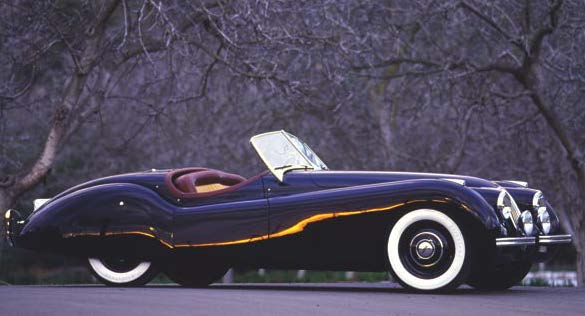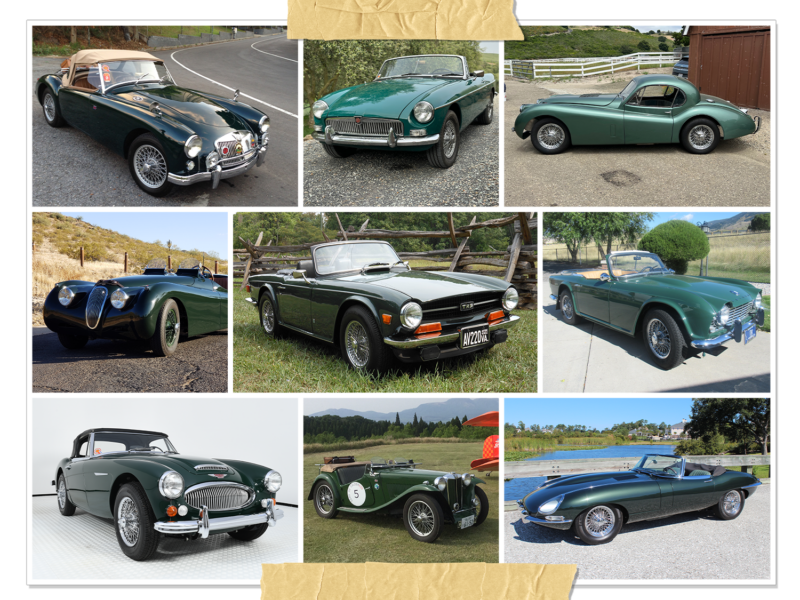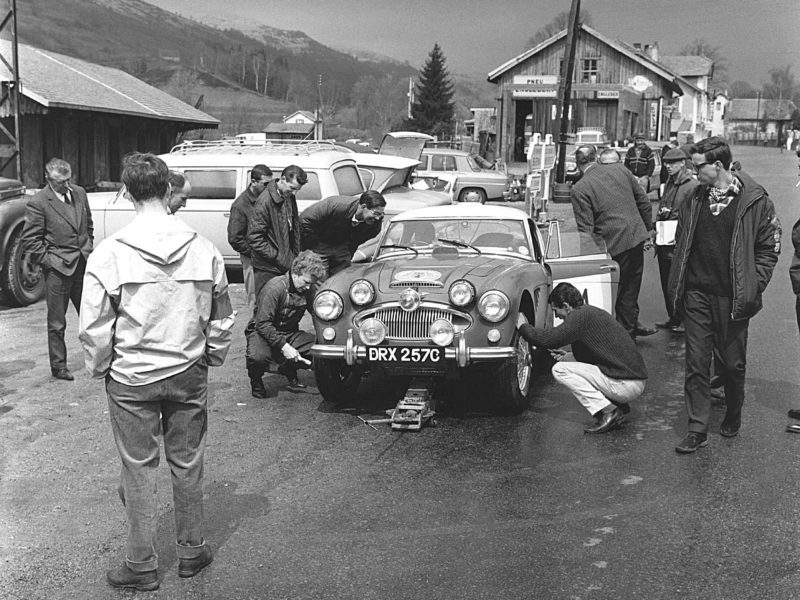The rare alloy-bodied cat that sired the American sports car
By Tom Morr; photography by Scott Dahlquist
One of the world’s most stunning sports cars has roots that burrow back to an English piano repair shop. Four decades before he was knighted by Queen Elizabeth, William Lyons toiled in his dad’s piano shop. This experience made one thing perfectly clear to the then teen: Lyons preferred working on his “oil-bath” Sunbeam motorcycle to fixing pianos.
Backstory
In a fateful event, fellow motorcycle enthusiast William Walmsley moved in across the street from Lyons in 1920. Walmsley fabricated an octagonal-looking sidecar for his military surplus Triumph motorcycle. Lyons admired it and had Walmsley make one for the Norton he was riding then. A few months later in 1922, Lyons and Walmsley borrowed money from their parents and formed the Swallow Sidecar Company. Lyons was 21.
By 1926, the company was making car bodies for Austin. The company name was appropriately changed to Swallow Sidecar and Coachbuilding Company. When Swallow added the Standard Motor Company’s Nine model to its reboyding portfolio, Lyons’ exterior designs began to attract attention.
Constrained to fitting his exoskeletons to somebody else’s framework, Lyons unveiled Swallow’s first production car in 1931. The SS1’s chassis was built to Swallow’s specifications by the Standard Co., and the car was powered by the reliable Standard 16 engine. At the time, the motoring press described the SS1 as “built for the connoisseur but [still] relatively low priced.” In 1935, Swallow introduced the SS90 sports car, the company’s first car to be named for its claimed top speed. A year later, Lyons bought out partner Walmsley, then unveiled the SS100, generally regarded as the first of his classic sports cars. It was later described as the “epitome of the stylish pre-war sports car.”
XK Genesis
Lyons’ second groundbreaking—and possibly his most industry upturning—sports car was the hastily executed Jaguar XK120. The car and company were both byproducts of WWII. Swallow contributed sidecars and aircraft components to the Allied effort, and Lyons added an in-house engineering department in preparation for post-war success. The company’s long-term agenda called for racier sports cars than could be produced using existing Standard Co. engines. So, an engine-development program was marked with an X for “experimental.” To avoid any references to the Nazi secret police, Lyons changed the company’s name from SS (Swallow Sidecar) to Jaguar Cars Ltd. after the name of an earlier SS sedan in 1946.
By the sixth-design XG iteration, the engine boasted race-bred technology. Pushrod designs were scrapped in favor of the more efficient and powerful dual-overhead cam. Lyons’ underlying goal was to produce a luxury car that could cruise at 100 mph.
Necessity then became the mother of invention. Jaguar wanted to unveil its new DOHC I-6 (finalized as the XK) at the 1948 London Motor Show, the first post-war British autorama. As the show drew closer, body-tooling problems dictated that the next generation Mark VII sedan chassis wouldn’t make the deadline as intended. A few weeks before the show, Lyons decided to display the new engine in a limited-production roadster based on a shortened version of Jag’s existing Mark V sedan. Legend has it that the car—originally dubbed the XK Open Two Seater Super Sports—progressed from concept to completion in approximately three weeks.
Lyons’ afterthought roadster stole the show. Priced at less than $4,000 and with a claimed top speed of 120 mph (thus its model designation), the Open Two Seater attracted orders far in excess of the projected 200 units. To meet the demand, Lyons knew that mass-produced steel body panels would be necessary. While the steel tooling was in progress, Jaguar handmade between 239 and 244 (estimates vary; 240 is most oft-quoted number) alloy-bodied XK120s between September 1948 and April 1950. Of these, 183 models were reportedly left-hand drive.
Styling
The XK120’s original function was twofold: a “design exercise” and a durability testbed for the new engine. William Lyons sculpted the body around a shortened Mark V sedan’s ash-framed chassis. Some say that the low, flowing lines were subconsciously inspired by Lyons’ affinity for motorcycles; the 1940 BMW Mille Miglia 328 was a more apparent influence. Rear skirts allowed the lines to waft unobstructedly from tip to toe. (The skirts had to be removed to clear wire wheels and knock-offs.) An intentional lack of door handles and turn signals further smoothened the package. The XK120 also introduced the vertical-ribbed oval grille, a signature cue that identified Jags for the ensuing two decades and is acknowledged by today’s S-Type.

Luxurious leather upholstery, a large steering wheel, and bold gauges defined the interior. The trunk provides the only lockable storage space. Alloy-bodied models lacked the later cars’ heaters/defoggers.
Performance
The XK engine was the 120’s raison d’etre. Jaguar engineers based it on a Standard Motor Co. block and integrated a BMW valvetrain design. The engine was the first mass-produced dual-overhead cam (chain-driven) model with hemispherical combustion chambers in the head. The same basic design carried through to the 1986 XJ6 and even as recent as the 1992 Daimler D420 limo.
With dual SU carbs, the 3.4L/210ci inline-six XK produced 160 hp—the same output as Cadillac’s concurrent 5.4L/331ci V-8. To prove the claimed 120 mph top speed, Jaguar took a group of journalists to Jabbeke, Belgium, in 1949. Prepped with a belly pan, tonneau cover, and sans windshield, an XK120 clocked in at 132.596 mph. Production trim brought that number down to 124. Any way it was sliced, the XK120 was the fastest production car in the world at the time.
Later XK120SE models (XK120M in the U.S.) bumped output to 180 hp thanks to larger carburetors, and the race-ready head of the C-Type models raised bhp to 210. Speaking of which, these race-prepped XK120Cs enjoyed near-immediate motorsports success, including wins at the Tulip Rally in 1951 and Alpine Rally from 1950-1952.

XK120 chrome was sparse and appeared on the windshield frame, seat frames, and rails. Its XK140 successor was festooned with more chrome in 1956 to pander to the perceived American predilection for brightwork.
Like all distinctive cars, XK120s have a few personality quirks. For starters, the SU carbs are temperamental. Their thermostat control is often upgraded with a manual override. XK120s also tend to overheat in stop-and-go traffic, and exhaust leaks aren’t uncommon. The gearbox’s long throws forestall quick shifts, and first gear isn’t synchronized.
The car’s handling also has some well-known idiosyncrasies. Steering feel is heavy, and the car has noticeable oversteer. The brakes fade quickly as they heat up, but the Citroen-inspired torsion-bar front suspension provides impressive handling that’s underscored by some front-end shimmy. This cat is regarded to be in its element at triple-digit speeds.
The Legacy
The alloy XK120 OTS shown here is owned by Southern California Jagophile Tom Krefetz (who also owns six E-Types at last count). It’s a concours-quality model of the car that (along with the MG TD) launched the sports-car craze in America: five years later, the first Corvette displayed similar bodylines, and the XK120 had a profound stylistic influence in its company’s subsequent D- and E-Type sports cars.
Early U.S. XK120 road tests were less restrained, although generally more exuberant, than their right-of-pond equivalents. In Mechanix Illustrated, Tim McCahill described the XK120’s road ride as “ like a bubble in a wash basin.” Fit and finish were suspect: “It would have been better if they had just shoveled the unassembled parts of the car I drove into an old bag and shipped them over parcel post.” However, McCahill concluded that the XK120 was the finest high-speed touring car in the world.
Historically, the XKI20 is generally regarded as one of the greatest cars of all time. The car is o ne of Sir William Lyons’ three stylistic triumphs (the 1936 SS100 and E-Type Jag being the other two). And the XK120 had the go to equal its show. Probably the best summation of the XK120 is “grace, space, and pace at an affordable price.”










'Jaguar XK120: Ali' has no comments
Be the first to comment this post!